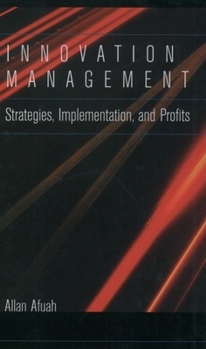Innovation Management: Strategies, Implementation, and Profits
Select Format
Select Condition 
Book Overview
Designed to meet the increasing number of courses in this vitally important area of business, Innovation Management is the first text to provide full course coverage of innovation management as its core theme. Drawing from his professional and academic experience, Allan Afuah shows the relationship between innovation, a management function, and profitability, a financial function. He creates a framework to encompass the basic questions of the who,...
Format:Hardcover
Language:English
ISBN:0195113462
ISBN13:9780195113464
Release Date:October 1997
Publisher:Oxford University Press, USA
Length:416 Pages
Weight:1.58 lbs.
Dimensions:1.0" x 9.3" x 6.4"
Related Subjects
Business Business & Finance Business & Investing Economics Education & Reference English as a Second Language Entrepreneurship Finance Foreign Languages Humanities Language Arts Linguistics Management Management & Leadership Marketing Organizational Change Product Management Reference Research Small Business & Entrepreneurship Words, Language & GrammarCustomer Reviews
2 ratings
A multi-dimensional framework "for all seasons"
Published by Thriftbooks.com User , 16 years ago
In this second edition, Allan Afuah develops in much greater depth many of the same concepts introduced in the previous edition (1998) but changed some of the terminology and rearranged the sequence of material while separating strategy issues from those concerning implementation and adding an entirely new chapter, "The Internet: A Case in Technological Change" (Chapter 16). He also incorporates many of the readers' reactions and suggestions generated by the earlier edition. However, he retains the same seven themes that "underpin the synthesis and intregrative framework" that can allow students of innovation "to get their minds around this increasingly important field - a framework that allows them to build on and make cause-and-effect predictions." That is again his goal in this second edition and he achieves it fully. Opinions are mixed as to whether or not it is possible to "manage" innovation. Perhaps some of the disagreements have to do with how manage is defined. Afuah seems to be among those (I among them) who believe that it is possible to establish and then manage an environment in which innovation can flourish, and it is also possible to manage the adoption, production, marketing, sales, and distribution of products that result from innovative thinking. In this context, I am reminded of what a French romantic poet (I think it was Baudelaire) said when asked how he wrote a poem. "First, I draw a bird cage, and leave the door open. Then I wait and wait and wait. Once in a while, a bird flies through the door. Then I erase the cage." In his introduction, Afuah poses a series of 17 questions and then answers them, devoting a separate chapter to each. Following Chapter 1, "Introduction and Overview," he organizes his material within four Parts: I (Chapters 2-4): Fundamentals (e.g. models of innovation) II (Chapters 5-10): Strategizing (e.g. strategies for sustaining profits) III (Chapters 11 and 12): Implementation (e.g. of the decision to adopt) IV (Chapters 13-17): Globalization (e.g. the role of national governments) Several books are invaluable sources concerning brainstorming, idea generation, etc. (notably Tom Kelley's The Idea of Innovation and The Ten Faces of Innovation) and Afluah fully understands and appreciates that process. However, the seven themes that he develops throughout his narrative (discussed later in this review) indicate that his perspective includes but is not limited to such activities. He thinks in terms of an entire enterprise, one whose strategy is based on several key factors that Afluah examines in Part II. When explaining how to create a foundation for execution, Jeanne Ross Peter Weill, and David Robertson observe: "The focus needs to be higher - on [in italics] enterprise architecture [end italics], the organizing logic for core business processes and IT infrastructure reflecting the standardization and integration of a company's operating model...[Therefore] enterprise architecture boils down to the
Suitable for everyone
Published by Thriftbooks.com User , 22 years ago
This book was recommended during my MBA at LUISS in Rome as the best possible reference for those who are interested in developing a thorough knowledge about Innovation and Corporate Strategy. It provides a complete overview on the subject, starting from which kind of company is more likely to innovate, how to overcome market uncertainties, what kind of human resources and network relationships you need to use, how to finance innovation and so on. The explanation is so fluid and the terminology so plain it could be easily read in a couple of days. Some useful case studies are also included. The only missing element is the strong emphasis on the IT sector. It would have been absolutely useful to include more cases on manifacturing and services companies. However, it should be considered one of the best available textbooks for Postgraduate students.





